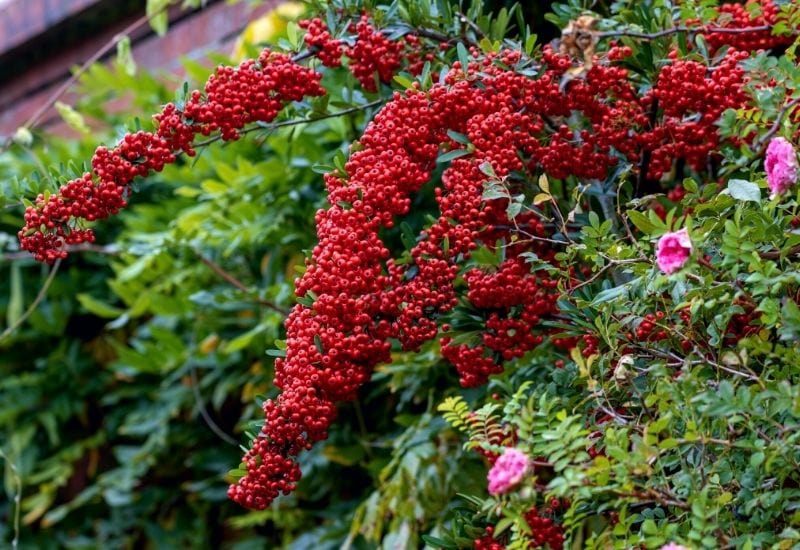
When winter sets in, your gardens don’t necessarily have to be bare, dreary, and devoid of color and vitality. After the leaves have fallen, trees and shrubs with red berries and fruits make their grand entrance.
The bright red fruit ornaments are very nice in contrast to white snow and go exceptionally well with the Christmas spirit in December. Therefore, they are often cut from branches of trees or shrubs and used for decoration in the house.
Kill two birds with one stone by planting trees and shrubs with long-lasting red berries and evergreen leaves.
They often appear in the fall and remain pleasant all winter long, taking over from the evergreen foliage; decorative fruiting of these plants will add a veritable firework display in the greyness. A festival of colors that will continue throughout the seasons as these trees and bushes know how to metamorphose.
What’s better than trees that keep both the green theme and add some sparks of energetic crimson or vermilion when there’s little else to look at? And to combine the useful with the beautiful, many fruit-bearing trees and shrubs also serve as a source of food for the birds in autumn and winter.
Discover the most beautiful evergreen trees and bushes adorn themselves with magnificent red berries that will transform the desert garden in winter into an oasis rich in colorful accents.
Green Leaves And Red Berries And Fruits In Shrubs And Trees
Green and red are special colors; used in gardening and landscaping, you can achieve harmonic or dramatic effects with shrubs and trees, shall we see why and how?
Why We Use Evergreens with Red Berries at Christmas
When the festive season comes, we see evergreen leaves and red berries on doors and mantle pieces all over the world. But why?
It really has nothing to do with Christianity… It’s an old Pagan tradition from Europe, when people wanted auspices for fertility in the new year!
And what’s better than a plant that never drops its foliage and even gives you red fruits, maybe when all the world is asleep?
And now, let’s talk about art.
Green and Red are a Perfect Combination for Your Garden
Green and red are complementary colors. This means that they balance each other off perfectly well. Green is relaxing, red is exiting.
Green gives structure, red gives depth… Green is the color of Nature, red the color of passion. Green gives you a sense of time being slow, red makes it go faster!
There are other sets of complementary colors, but they are not as eye pleasing as these two: yellow and purple clash, as do blue and orange;
these give you contrast, while green and red give you harmony. This is especially clear when it snows, and the background becomes neutrally white.
Balance Green and Red in Your Garden with Shrubs and Trees
Careful though, red can easily become “too much”. It is the most dominant color we have, the first we see among all colors. If there is more green than red, you get a balanced effect.
So, the idea is always to have more of the color of Nature and less of that of passion, unless you want real drama in your garden or on your terrace, that is.
You can do this by mixing other evergreen shrubs and trees with some of the ones you are going to see now, especially those that have massive displays of red fruits and berries…
12 Great Evergreen Trees And Shrubs With Red Fruits And Berries
Red berries and fruits with evergreen foliage is what all the shrubs and trees of this selection have in common, but let’s see also how they differ! And they are not just for Christmas…
1: English Holly (Ilex aquifolium)
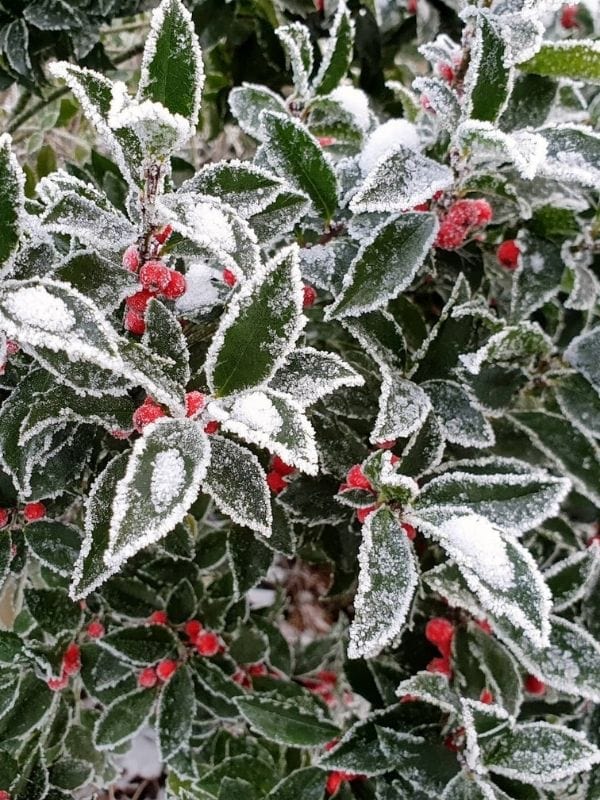
The queen of all evergreen shrubs with red berries is English (or common) holly! And you can train it into a tree too.
The red clusters of fiery pearls ripen just in time for the Christmas season, and you will find them at the tips of the branches mixed in with the iconic leaves of this plant.
The spiny, hard and very glossy green foliage is in itself very decorative. You may need a male plant to get the berries on the female one, but it’s all well worth the effort.
These plants have a pyramidal habit, and there are famous cultivars like ‘Red Beauty’ and ‘Blue Boy’. And be prepared for visiting birds!
English holly is ideal for specimen and foundation planting, giving you structure and color all year round; alternatively, it will mix well with other plants in informal hedges and windscreens. You can adapt it to formal designs, but it will require much higher maintenance.
2: Spotted Laurel (Aucuba japonica)
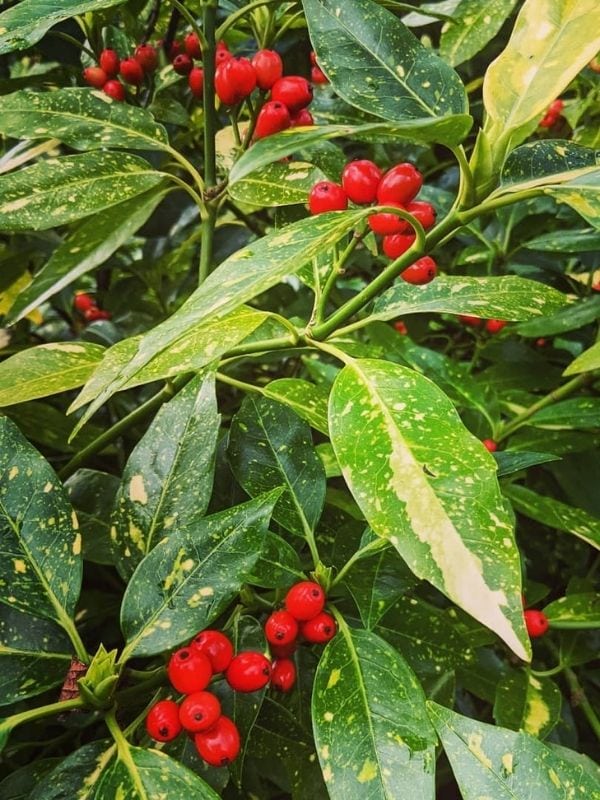
The name “spotted laurel” is misleading, as it is not related to Laurus, and in fact its leaves are softer, light to dark green with cream yellow spots; oval and often bending, they form a thick and dense shrub with a lovely color pattern and a glossy sheen.
Purple flowers will appear in spring, and they will give way to glossy bright and deep red berries with an oval shape on female individuals.
These will play hide and seek among the foliage, with a lovely and colorful display that can last into early spring!
Spotted laurel is very adaptable; you can grow as foundation planting, but also in hedges, borders and wind screens. And don’t worry if you only have a terrace; a nice container will do perfectly well!
3: Heavenly Bamboo (Nandina domestica)
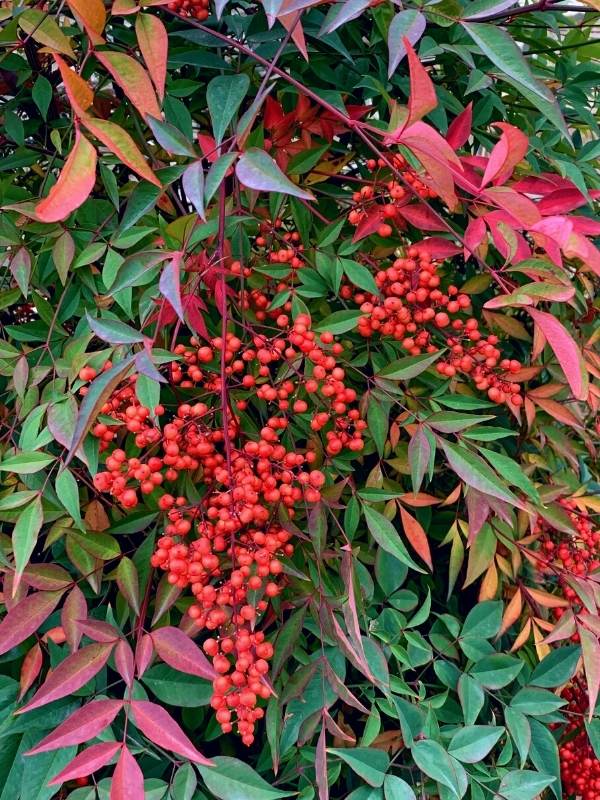
Heavenly bamboo is an original entry in our selection of evergreen shrubs with red fruits, or glossy bright green berries in our case.
They come in large clusters, like “grapes of fire” after the tiny but plentiful white flowers that come in spring are spent. As the berries turn from green into their ripe color, the foliage changes too!
The elegant pinnate and arching leaves are green in the early months of the year, but as fall approaches, they start turning red and purple.
This is a shrub you want for a continuous and ever changing chromatic spectacle on your balcony or in your garden.
Heavenly bamboo is a very tough plant, low maintenance and adaptable. Grow it in borders and hedges, for foundation planting or even under trees and in woodland areas. It will also be perfect in a Japanese or oriental garden. Be careful though, all the plant is toxic.
4: Chilean Guava (Ugni molinae)
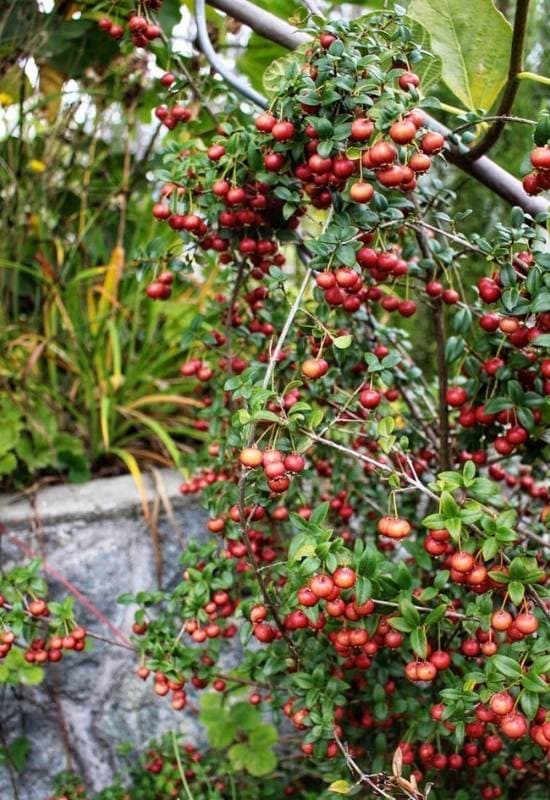
With Chilean guava you get three for the price of one: evergreen foliage, beautiful flowers and berries! The leaves are glossy, elliptical and dark green.
In spring clusters of super fragrant, bell shaped pink and white flowers appear hanging from the branches. They can keep blooming into summer as well.
They turn then into large dark red berries, ½ inch in size (1 cm) which you can eat, or turn into jams. The foliage too can get blushes of red, adding to the color display.
Ideal for warm gardens, Chilean guava will grace hedges, borders and containers in Mediterranean, city and courtyard gardens and terraces alike, as long as informal in inspiration.
5: Bearberry Cotoneaster (Cotoneaster dammeri)
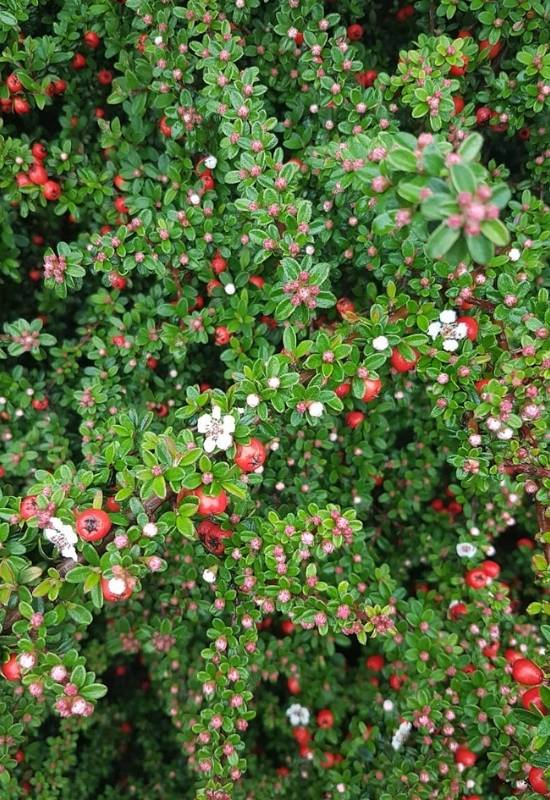
Bearberry cotoneaster is an evergreen shrub that gives you a “natural” Italian flag, with green foliage, white flowers and red berries all at the same time!
The effect is lovely and light, with a very fine texture and pattern. The leaves are small, mid green and oval, the blooms are small too, with five round white petals, and purple anthers;
and the berries coriaceous and bright red. Imagine them all together on a dense shrub with trailing branches and you get the picture!
You can grow bearberry cotoneaster on slopes, as edging or even as ground cover, thanks to its trailing habit, which makes it ideal for rock gardens as well.
6: ‘Repens Aurea’ English Yew (Taxus baccata ‘Repens Aurea’)
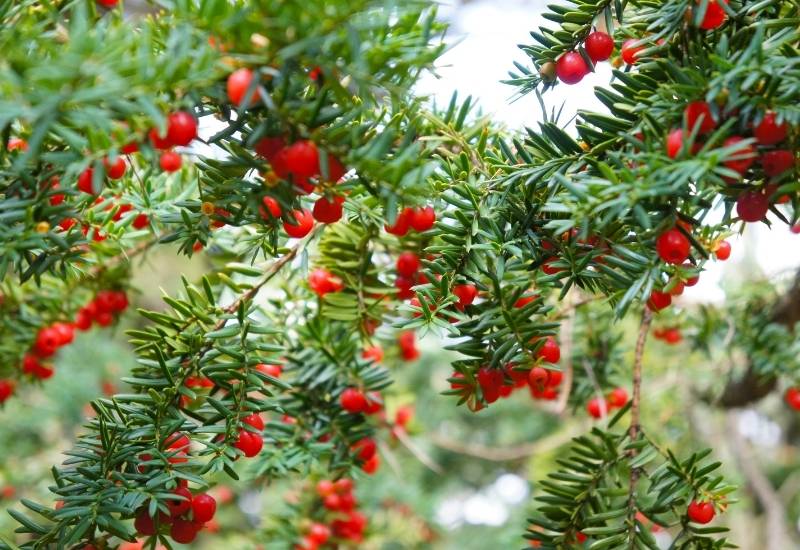
‘Repens Aurea’ is a conifer shrub of the yew genus with some special features for your garden. The dense and evergreen foliage is bright green with golden flushes, and it comes on the arching and pendulous branching of this spreading bush.
It will not bloom, but it will produce berry like cones that of a lovely coral red shade. You rarely get a big display, but they still look lovely when they come..
The overall effect is bright and full of light, and maybe this is why the Royal Horticultural Society has rewarded it with the Award of Garden Merit.
‘Repens Aurea’ is a cultivar you will enjoy as ground cover, as specimen plant in rock gardens, courtyard and city gardens, maybe next to steps, or arching over low walls. It is well suited to shady gardens.
7: Korean Barberry (Berberis koreana)
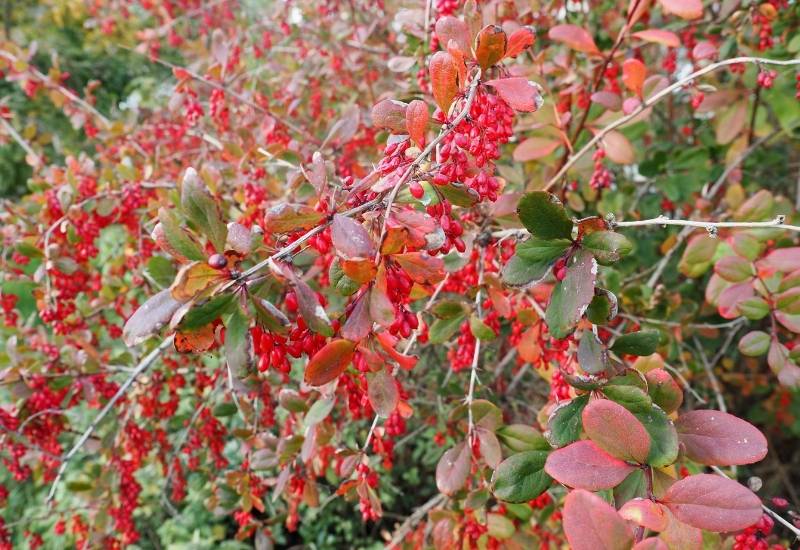
Korean barberry is evergreen only in warmer climates, in colder ones it may drop some or all of the leaves, but still… How can you resist the clusters of bright red and egg shaped berries that hang from the branches in the late months?
And they follow equally beautiful drooping flowers of the brightest yellow! The leaves are bright green most of the year, but then they take on russet to maroon and purple tones in fall and winter.
While it may shed them in severe climates, it is very cold hardy, so don’t worry if it does; they will come back in spring. The branches till look lovely though, reddish in color and with spikes.
Korean berry has a wild, woodland look; use it for informal, cottage and traditional garden as part of your borders, hedges or wind screens, even as foundation planting and in shady, naturalized and woodland areas.
8: Strawberry Tree (Arbustus unedo)
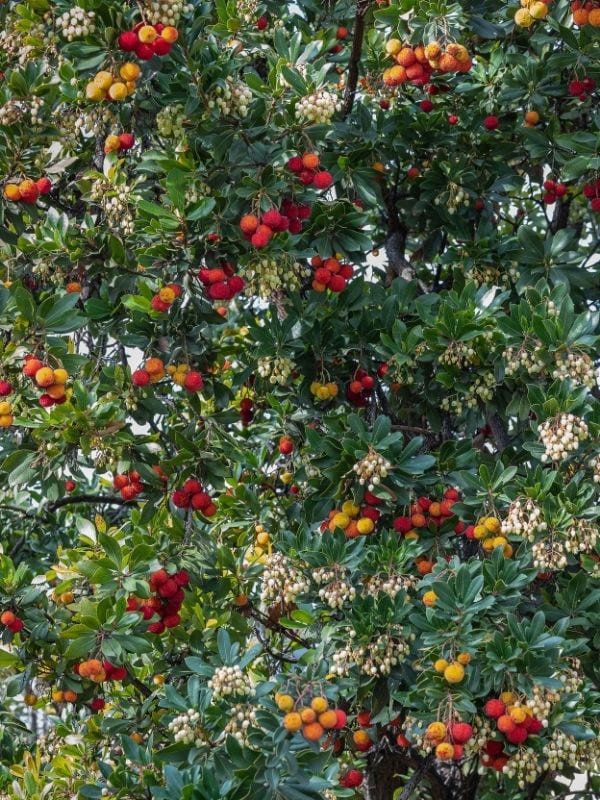
Strawberry tree is different from the evergreen shrubs and trees we have seen so far; it has large round fruits that ripen over a whole year, going from green to yellow to bright red when they are finally mature.
This means that they will share the branches with the clusters of nodding, urn shaped, cream and very fragrant flowers that come in fall and winter.
The leaves are mid green and broad, elliptical and serrated, not too dense and pointing up, while the “strawberries” hang underneath.
Red, cream, green and yellow can all be on this bush at the same time, and you can even turn it into a small tree.
Strawberry tree is perfect for Mediterranean and coastal garden, but it won’t loom out of place in borders, hedges and as foundation or specimen planting in other informal designs. And don’t forget that the fruits are edible!
9: ‘Red Cushion’ Scarlet Firethorn (Pyracantha coccinea ‘Red Cushion’)
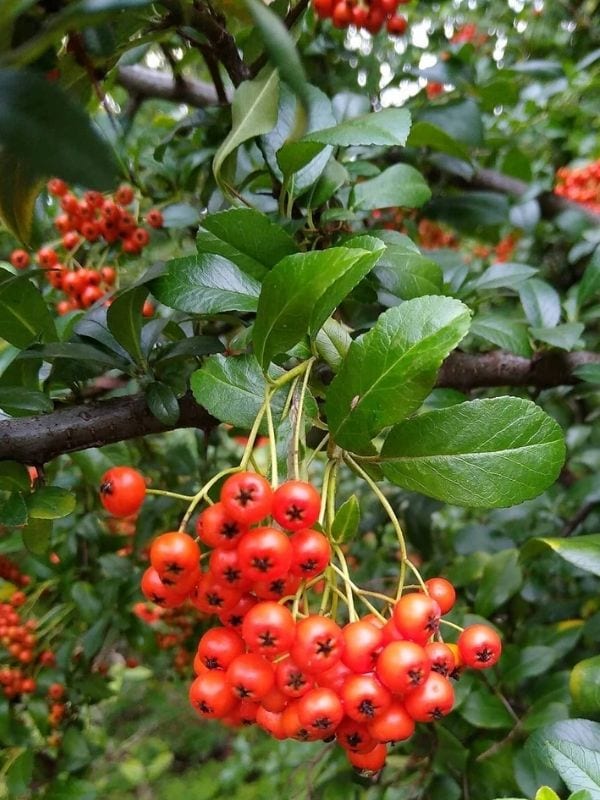
The name of ‘Red Cushion’ scarlet firethorn says it all about this evergreen shrub. Noted for its spiked branches and regular, tidy habit, it fills with a sea of scarlet red berries in clusters, each with a flattened round shape, looking like miniature apples.
But it is also a massive bloomer, with tiny white flowers that come in spring and continue into the early months of summer.
The foliage is mid green, glossy and finely textured thanks to the small and oval leaves, not too dense, but lush enough to set off blossoms and fruits well.
‘Red Cushion’ scarlet firethorn has a very temperate woodland personality; grow it in informal gardens, as a wall side shrub, in hedges or even as foundation planting.
10: Evergreen Dogwood (Cornus capitata)
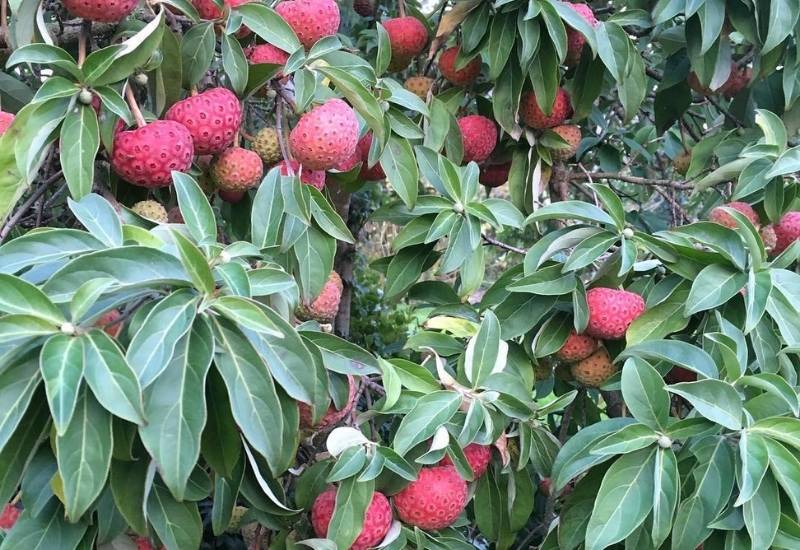
Evergreen dogwood is the big outsider in our selection of evergreen trees and shrubs with red berries and fruits…
It is far too exotic to fit the Christmas theme, but nevertheless a rare beauty! The green foliage is elliptical, mid green and arched, like that of peach trees, not too dense but lush.
The blooms are dour round, cream white and very showy bracts that look like petals on the branches from early to mid summer.
Them you will see large, bright red berries hanging on pendulous red stems, that look like oversized berries… Don’t just “look” at them… pick them too, as they are quite a treat for you and for birds if they get there first!
Evergreen dogwood is a tropical looking shrub or tree that can’t be missed in any garden, especially in tropical, Mediterranean or coastal gardens, where it really gives its best!
11: Japanese Skimmia (Skimmia japonica)
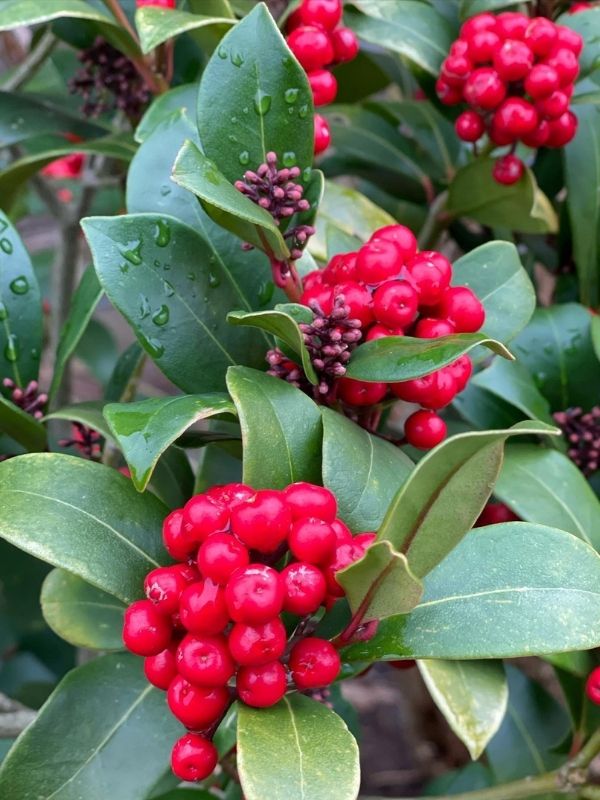
Japanese skimmia is the ideal soft looking evergreen shrub with red berries for shady gardens. It has very dense, broad, oval mid green leaves with a nice aroma; they form mounds of lush foliage all year round, with a spreading habit.
By mid spring you will see large and thick clusters of cream and pink star shaped blooms, that form interesting and very fragrant plumes above the greenery.
Then, on female plants, the flowers give way to bright and glossy candy red berries in groups, and they will stay on till winter.
Plant male and male individuals nearby for best effect, especially on banks and slopes, in borders and hedges, woodland areas and traditional looking gardens, and you will not regret it!
12: Peruvian Peppertree (Schinus molle)
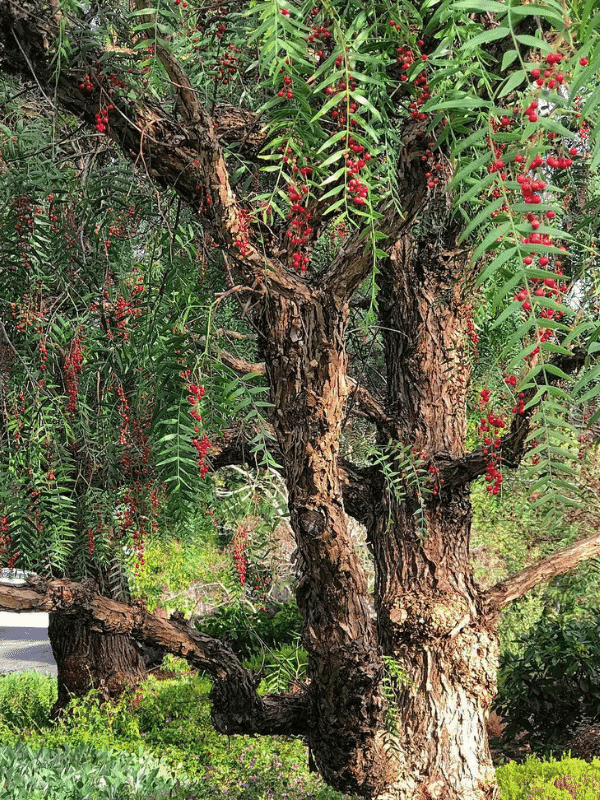
Peruvian peppertree is a very elegant evergreen tree with edible berries. The branches have a weeping habit, and they are covered in light green, finely pinnate leaves that look like fronds and wave beautifully in the wind.
The texture is very sophisticated, and the round shape of the crown makes this small tree even more valuable for its architectural qualities. Clusters of yellow and green flowers will appear in July and August.
The green berries that follow will be ready for the picking by December, when they turn red. And yes, the name is not random! They taste of black pepper and they are in fact a great substitute for this spice!
Peruvian pepper is a very attractive plant for many types of gardens, as specimen or foundation planting; the foliage is so delicate looking and easily trimmed that it could even fit formal gardens, pool sides, and exotic gardens alike.
Evergreen Shrubs And Trees With Red Berries – An Eye-Catching Color Festival In The Winter Garden
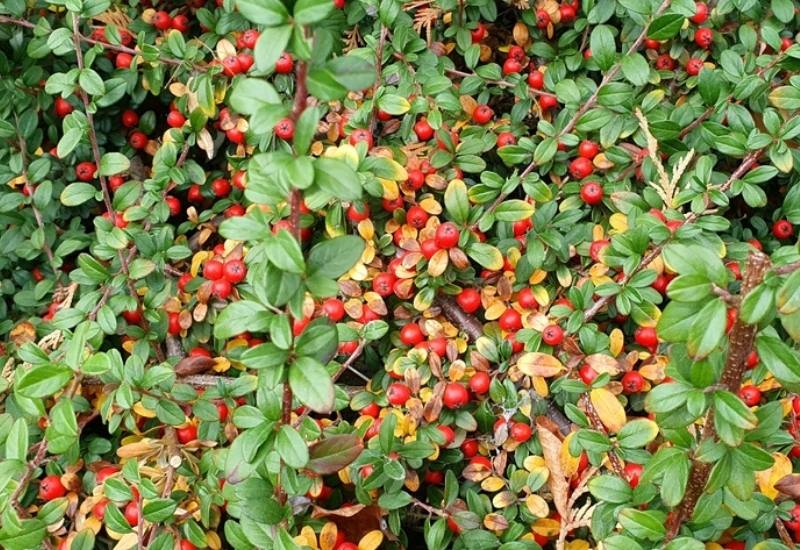
Ok, most of our plants will look great during the festive season too, and they will have bright red berries and fruits just when gardens are barren and fire places need decorations, but…
With flowers and lovely leaves at other times of the year, cold or exotic personalities, round, spreading or pyramidal habits, for sure, they can grace your garden 12 months a year, and not just when it’s cold!

Written By
Adriano Bulla
After many years as an academic in London, Adriano Bulla became a writer, publishing books like A History of Gardening, Organic Gardening and Elements of Garden Design; he then decided to become a gardener, following his childhood dream, and has been following his dream writing and gardening professionally in Southern Europe, where he has specialized in new and innovative organic gardening fields and techniques, like permaculture, regenerative agriculture, food forests and hydroponics.

The red berry tree i have found in the woods is nothing like these. Please expand your article.